MP3
| Location: Walpeup. | Australian Soil Classification: Epibasic, Argic, Calcic CALCAROSOL (very deep sandy profile). |
| Northcote Factual Key: Uc 3.31. | Geology: Quaternary aeolian deposits. |
| General Landscape Description: East-West dune. |
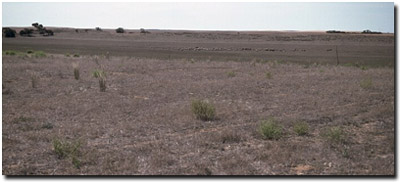 MP3 Landscape |
Soil Profile Morphology:
Surface Soil
| A1 | 0-15 cm | Brown (7.5YR5/4); loamy sand; structureless (single grain); weak consistence dry; non calcareous; pH 7.8; abrupt and wavy change to: |
 MP3 Profile |
| A2 | 15-35 cm | Strong brown (7.5YR5/8) with sporadically bleached reddish yellow (7.5YR7/6d) layers; loamy sand; massive; weak consistence dry; contains very few (< 2%) fine-earth carbonates; pH 8.2; sharp and irregular change to: | |
| Subsoil | |||
| B21 | 35-55 cm | Reddish yellow (7.5YR6/7); clayey sand; massive; firm consistence dry; very few (< 2%) fine-earth carbonates; pH 8.5; sharp and smooth change to: | |
| B22 | 55-80 cm | Reddish yellow (7.5YR6/8) and yellowish red (5YR5/8) in bands; clayey sand; massive; firm consistence dry; fine-earth carbonates common (10 %); pH 8.9; sharp and irregular change to: | |
| B23k | 80-100 cm | Reddish yellow (7.5YR6/6) with occasional reddish yellow (7.5YR6/8) bands; sand; massive; fine-earth carbonates common (10 - 20%); pH 9.3; sharp and irregular change to: | |
| B24 | 100+ cm | Layers of yellowish red (5YR5/8) clayey sand and reddish yellow (7.5YR6/8) sand; massive; weak consistence dry; few (2 - 10%) fine-earth carbonates; pH 9.1. | |
Key Profile Features:
- Some of the surface horizon material is anthropogenic (i.e. formed due to human activities associated with clearing).
- Soil profile dominated by coarse and fine sands.
- Presence of argic horizons (i.e. distinct clayey lamellae within some horizons).
Soil Profile Characteristics:
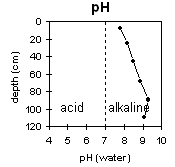 | 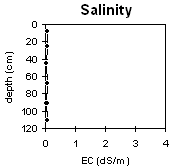 |
The surface soil is slightly alkaline. The upper subsoil is moderately alkaline, becoming very strongly alkaline with depth. | The level of soluble salts is extremely low throughout the profile. |
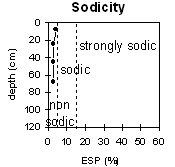 | 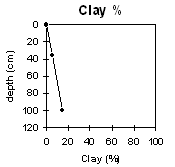 |
The profile is non-sodic throughout. | The clay content is low in this profile and increases in the subsoil. |
Whole Profile
- In general, management strategies for all soils should aim to increase organic matter levels in the surface soil; minimise the degradation of soil aggregates and porosity; promote the development of stable biopores; improve the calcium status of the ion exchange complex (particularly when sodium is a significant part – i.e. sodic), and break up any hardpans. Less frequent tillage; using less aggressive implements, and working the soil at optimum moisture conditions can all assist in maintaining soil aggregation and porosity as well as reducing the breakdown of organic matter.
- The low wilting point values (ranges from 1.9 to 3.2) throughout the profile indicates that plants will be able to utilise light rains during dry periods, by taking up water immediately. However, due to the soils low water storage capacity, plants will suffer moisture stress unless further rains occur.
- Plant available water capacity (PAWC) will be quite low for this sandy soil profile. However, it is likely that horizons with more clayey bands will provide enhanced water holding capacity – compared to sandy soils in the region without these bands.
- The surface soil has a very high sand content. The levels of organic carbon measured at the pit site is quite low (this may or may not be representative of the whole paddock). Organic matter levels will decline if cropping takes place and can be improved by adopting practices such as residue retention, minimum tillage and utilising pasture rotations. Increased organic matter will both improve aggregation as well as enhance water holding capacity and fertility and reduce erosion risk.
- The upper subsoil is moderately alkaline becoming very strongly alkaline at about 80 cm depth. This indicates that some nutrients (e.g. manganese, zinc, iron, copper) may be poorly available to deeper-rooted species. Boron toxicity can occur in very strongly alkaline soils – but boron levels have not been measured at this site.


